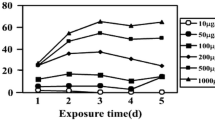Abstract
Effect of 2,4-dinitrophenol (DNP) was studied onNigella sativa to note the changes in mitosis, DNA, RNA and protein synthesis. The chemical affected division frequency considerably and chromosomal abnormalities like sticky bridge, fragmentation, micronucleietc. were recorded. By using precursors of nucleic acid and protein synthesis, it was found that DNP also inhibited DNA, RNA and protein synthesis. The decrease in division frequency can be correlated with the DNA synthesis.
Similar content being viewed by others
References
Amer, S. M., Ali, E. M.: Cytological effects of pesticides. IV. Meiotic effects of some phenols. -Cytologia34: 533–540, 1969.
Ashtost, F. M., Crafts, A. S.: Mode of Action of Herbicides. -A. Wiley -Interscience Publication, New York-London-Sydney-Toronto 1973.
Ephl, D.: The effects of carbon monoxide inhibition on ATP level and the rate of mitosis in the sea urchin egg. -J. Cell Biol.17: 315–319, 1963.
Gaur, B. K., Beevers, H.: Respiratory and associated responses of carrot discs to substituted phenols. -Plant Physiol.34: 427–432, 1959.
Hindmarch, M. M.: A critical consideration of C-mitosis with reference to the effects of nitrophenols. -Proc. linn. Soc. N. S. Wales76: 158–163, 1951.
Kandler, O.: Energy transfer through phosphorylation mechanisms in photosynthesis. -Annu. Rev. Plant Physiol.11: 37–54, 1960.
Kihlman, B. A.: Action of Chemicals on Dividing Cells. -Prentice Hall Inc., New Jersey 1966.
Levan, A., Tjio, J. H.: Induction of chromosome fragmentation by phenols. -Hereditas34: 453 to 484, 1948.
Mitchell, P.: Coupling of phosphorylation to electron and hydrogen transfer by a chemi-osmotic type of mechanism. -Nature181: 144–148, 1961.
Sharma, A. K., Ghosh, S.: Chemical basis of the action of cresols and nitrophenols on chromosomes. -Nucleus8: 183–190, 1965.
Sikka, K., Sharma, A. K.: The effect of some herbicides on plant chromosomes. -Proc. indian. nat. Sci. Acad.42 (Part B): 299–307, 1976.
Takatori, S.: Effects of some respiratory inhibitors on the durations of the different stages Of the mitotic cycle ofVicia root tip cells. -Cytologia31: 220–235, 1965.
Van’t Hof,J., Wilson, G. B.: Studies on the control of mitotic activity. The effect of respiratory inhibitors on mitotic cycle times in the root meristem ofPisum sativum. -Chromosoma13: 39–46, 1962.
Weinbach, E. C.: Biochemical basis for the toxicity of pentachlorophenol. -Science124: 940, 1956.
Author information
Authors and Affiliations
Rights and permissions
About this article
Cite this article
Chand, S., Roy, S.C. Effects of herbicide 2,4-dinitrophenol on mitosis, DNA, RNA and protein synthesis inNigella sativa L.. Biol Plant 23, 198–202 (1981). https://doi.org/10.1007/BF02894886
Received:
Accepted:
Issue Date:
DOI: https://doi.org/10.1007/BF02894886




